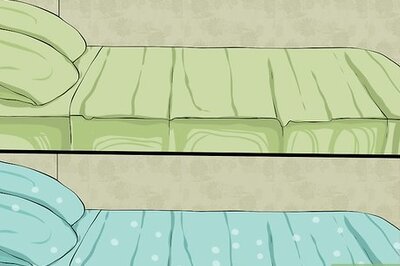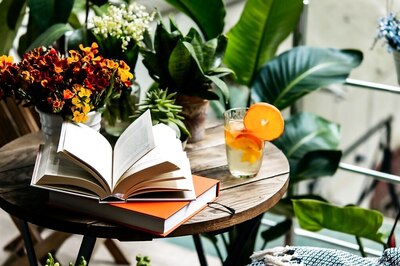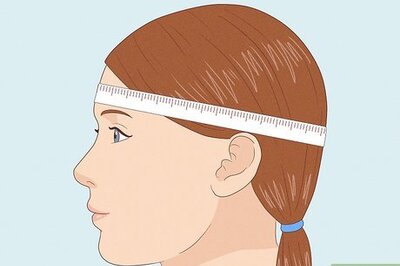
views
What is ruddy skin?
Having a “ruddy complexion” means your skin has a healthy, reddish glow. “Ruddy” means red or reddish and is most often used to describe a fair-skinned person’s complexion, particularly when they normally look pale but become flushed (although some folks have a reddish tint all of the time). It’s generally considered a good thing and a sign of good health, but can sometimes be used derogatorily or be an indicator of a skin condition like rosacea. Fun fact: In British slang, “ruddy” is used as a replacement for negative or curse words. You might tell someone to “Close the ruddy door!” (“Close the damn door!”) or exclaim “Ruddy hell!” to avoid saying “Bloody hel!”
What causes a ruddy complexion?
Sunburn This seems like an obvious cause, but many people underestimate how much sun exposure their face gets each day. Spending lots of time outdoors without sunscreen will cause your skin to turn red if your complexion is fair. You can tell if the sun is causing your ruddy complexion because only the parts of your face that were exposed to sunlight will turn red.
Acne Inflammatory acne causes red, swollen bumps to appear on your face. These bumps and pimples are like mini-infections, so your body sends white blood cells to fight them. This surge in white blood cells can cause redness and inflammation on your face (or wherever your acne is), affecting your complexion until the pimples subside.
Exercise After an intense workout, you probably feel pretty warm. To cool down, your body dilates your blood vessels to move blood closer to the surface of your skin. This gives you a red or ruddy post-exercise glow.
Exposure to extreme hot or cold Just like with exercise, if you’re feeling extra hot (like on a scorching summer afternoon), you may develop a ruddy complexion as your body tries to cool off. However, it’s not just heat that can make you red—super cold, dry air can make your complexion look temporarily red, too. “Winter rash” is a condition where dry, cold air strips your moisture barrier away, leading to redness, flakiness, itching, and even blisters or sensitivity.
Rosacea or other skin conditions Sometimes, a ruddy complexion may be a symptom or early indicator of a larger condition. Rosacea is a well-known example—people with the condition experience easy flushing or blushing, and the duration and intensity of the redness tend to increase as time goes on. Other possible conditions include seborrheic dermatitis (a type of rash), eczema, psoriasis, or even lupus or shingles.
Spicy foods or alcohol Capsaicin (the substance that makes spicy food hot) can trigger a red flushing reaction, particularly if you have a condition like rosacea. Similarly, people who metabolize alcohol slowly may get hit with the “alcohol flush reaction.” This is when acetaldehyde (a byproduct of breaking down alcohol) builds up in your blood and makes your face look red.
Genetics Some people are just born with a ruddy complexion, or may be more prone to blushing due to genetics. Certain conditions that cause a red complexion, like rosacea or “alcohol flush reaction,” tend to be inherited as well.
Skin irritation or allergic reactions Contact dermatitis is a condition that develops when something irritates your skin or causes an allergic reaction touches your face. This might be caused by harsh skincare products (irritants) or allergies to materials like poison ivy, fragrances, or latex (allergens). Typically, the redness or ruddiness subsides once you’re out of contact with the irritant or allergen. Reactions to medications may also make your face red.
Harsh skincare products Super drying or irritating skincare products, like face washes with alcohol, can strip moisture from your face and make it look ruddy. Similarly, overusing gentler products (like washing your face multiple times throughout the day) can also dry you out or cause ruddy irritation.
How to Manage a Ruddy Complexion: Lifestyle & Skincare Solutions
Use sunscreen daily. For everyday use, apply a sunscreen with SPF 30 or higher each morning while you’re getting ready (or SPF 60 if you plan to spend lots of time outdoors). It’s recommended to reapply every 2 hours, especially if you’ve been sweating or swimming. Try using a daily morning moisturizer with SPF in it to both moisturize and protect your skin from the sun’s UV rays. Protection from UV rays will minimize the redness and sunburn from sun exposure.
Avoid harsh skincare products. If you have rosacea or easily irritated skin, choose products that are non-comedogenic (won’t clog your pores) and made for sensitive skin. Opt for creams over lotions or gels, and steer clear of astringents and toners. “Most of the skincare lines will have some redness products, like cleansers that help with redness and soothing serums, which can be helpful,” adds Dr. Richmond. There are also certain ingredients in skincare and cosmetic products you can avoid to decrease the likelihood of a flushing episode or extra redness. These include: Alcohol Camphor Fragrances Glycolic acid Lactic acid Menthol Sodium lauryl sulfate (often found in shampoos and toothpaste) Urea
Moisturize after you wash your face. It’s recommended to wash your face twice a day (with a gentle cleanser if you’re prone to redness). After each wash, apply a fragrance-free, non-irritating facial moisturizer to keep your skin hydrated and less irritated (and therefore, less red). If you’re already undergoing treatments for conditions like rosacea, moisturizing regularly can improve the results you see from your treatment.
Try not to over-exfoliate. Exfoliating your face removes dead skin cells, makes your skin look brighter, and evens out your skin tone—but overdoing it can leave your face dry and red. If you notice redness, dryness, or irritation after exfoliating, cut back on how often you do it. Some folks can handle a daily exfoliation, and others may benefit most from only doing it once or twice a week 9espeially if you have sensitive skin). Try cutting back to just once a week and see if that makes a difference in your ruddy complexion.
Avoid triggers that cause you to blush or flush. Certain things, like exercise or spicy food, can cause your face to turn ruddy—particularly if you have a condition like rosacea. “Minimizing those triggers is helpful…whether that’s heat, exercise, spicy foods, or alcohol” explains Dr. Richmond. “Do things to minimize the flushing, like not exercising outside when it’s hot, trying to be in a cooler room, minimizing sun during exercise, and drinking plenty of water to stay hydrated.”
Visit your dermatologist if your complexion makes you insecure. A dermatologist can find the right treatment to soothe your complexion, especially if you have an underlying condition causing the redness, like rosacea. Depending on the cause, medications or other remedies may be recommended. “There are a couple medications that constrict the blood vessels on the surface of the skin” like Rhofade (oxymetazoline) and Mirvaso that are great for rosacea, Dr. Richmond explains. “They essentially minimize redness or flushing during the day. You apply a thin coat in the morning, and it lasts for several hours, and you typically do it daily. Some patients respond very well to these medications, [but] there is a small risk of rebound redness.” “I also do a lot of laser treatments for the redness, which are highly effective,” Dr. Richmond continues. “We have a pulsed dye laser, which is called V-beam, which we use to help remove enlarged capillaries and background redness. It can take a few treatments, but it has excellent results.”
How to Manage a Ruddy Complexion: Makeup
Apply a sheer green-tinted primer as your base. Since green is the opposite of red, a green base can visibly reduce redness and even out your skin tone. Plus, having a base layer on will help your makeup last longer. Apply a light layer all over, adding more as needed over red or ruddy areas, and blend with a damp sponge. Try using a green-tinted primer with UVA/UVB protection to shield your skin from sun exposure.
Follow up with foundation that matches your skin tone. Next, dampen a brush and pat on a layer of your go-to foundation (a damp brush helps blend the primer and foundation without streaks). Touch up with concealer as needed over spots that need more coverage, but don’t go overboard. Now that your skin has a slight green tint, you’ll need less coverage than normal. Choose a foundation that matches your natural skin tone as much as possible. If you have rosacea, use an oil-free foundation to avoid irritating your skin. For concealer, choose a shade that’s 1 shade lighter than your skin tone.
Go easy on the blush (or don’t add any at all). Since your skin already has natural color in it, use blush or any kind of cheek color sparingly. If you want to try some, use a sheer blush for sensitive skin. Apply it with a brush (and a light touch), sweeping from the apples of your cheeks toward your temples. If you’ve got very ruddy skin or rosacea, finish your look with gentle eye makeup for sensitive skin and neutral lip shades that are close to your natural lip color (avoid reds that can bring out the redness in your complexion).
Set your skin with setting spray or translucent setting powder. Finish off with a light mist of setting spray for sensitive skin or a dusting of powder for sensitive skin to lock in your makeup. If your skin is feeling or looking a little dry, add a spritz of a hydrating mist once your spray or powder is set.
Frequently Asked Questions: Ruddy Complexions
What’s the best hair color for a ruddy complexion? If you’re thinking about dying your hair, ash or a cool hair color with undertones of blue or violet to help tone down redness. Neutral colors also look great on basically anyone!
Which skin types get a ruddy complexion? Any skin type, from oily to dry, can get a ruddy complexion. All shades of skin tones and colors can get a ruddy complexion, too. However, it’s most noticeable and associated with fair-skinned people since redness from their blood vessels is more visible.
What does “ruddy complexion” mean on a draft card? During World War II, soldiers filled out draft cards, which included a series of checklist questions to describe their appearance on the back. Their choices for complexion included “sallow, light, ruddy, dark, freckled, light brown, dark brown, and black.” In this case, ruddy was associated with a healthy, reddish glow complexion.
What does “ruddy” mean in the Bible? In the Bible, “ruddy” is a positive word for red-tinted skin, often used in praise (although in some instances, it may refer to red hair). The darker-skinned Hebrew people were said to find this complexion beautiful. For example, in 1 Samuel 16:12, David is described as “ruddy, with beautiful eyes and a handsome appearance.” Here, “ruddy” highlights a youthful and appealing appearance, setting him apart as God's chosen one.




















Comments
0 comment